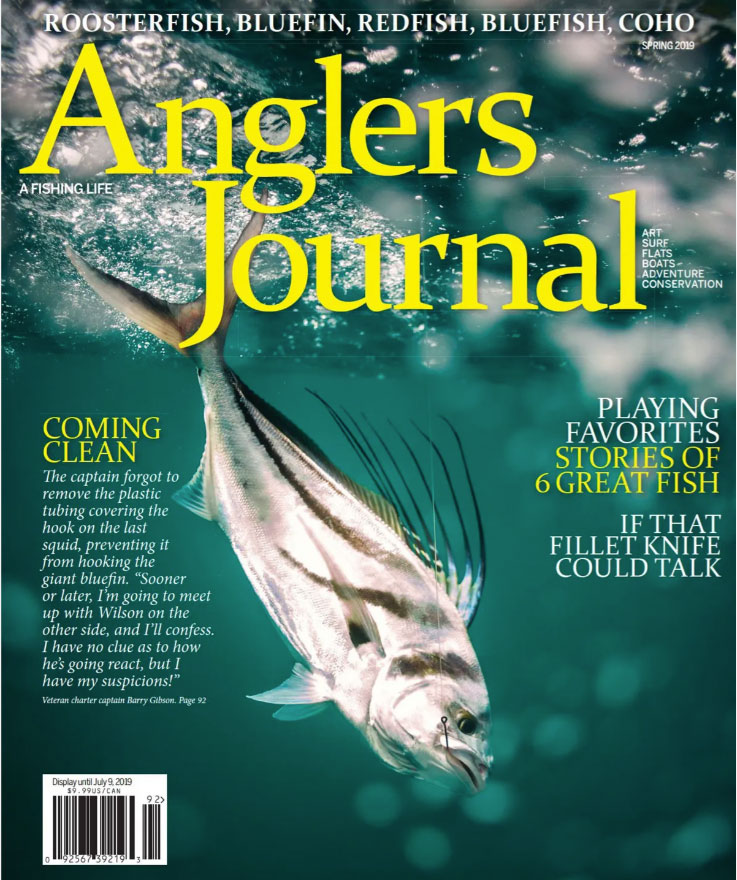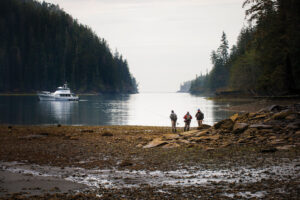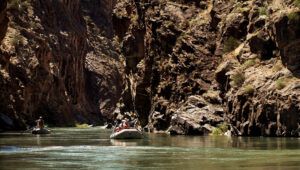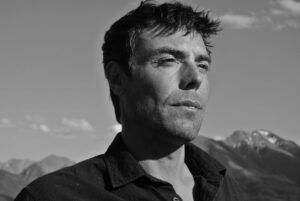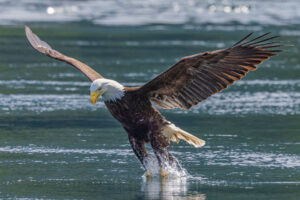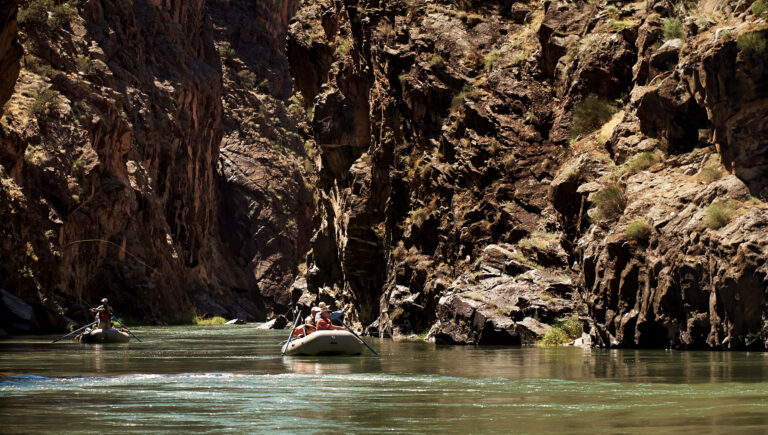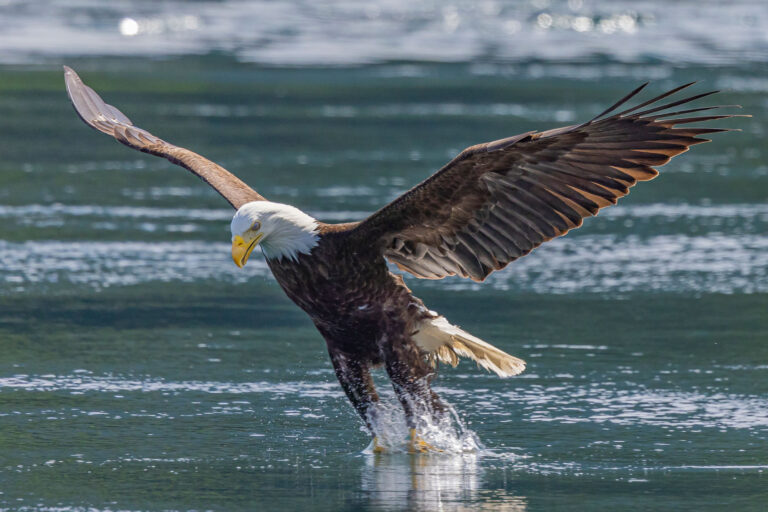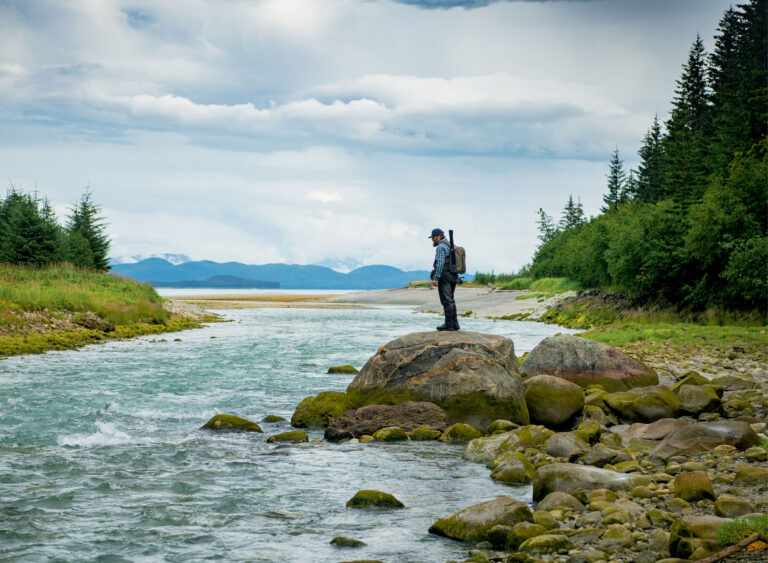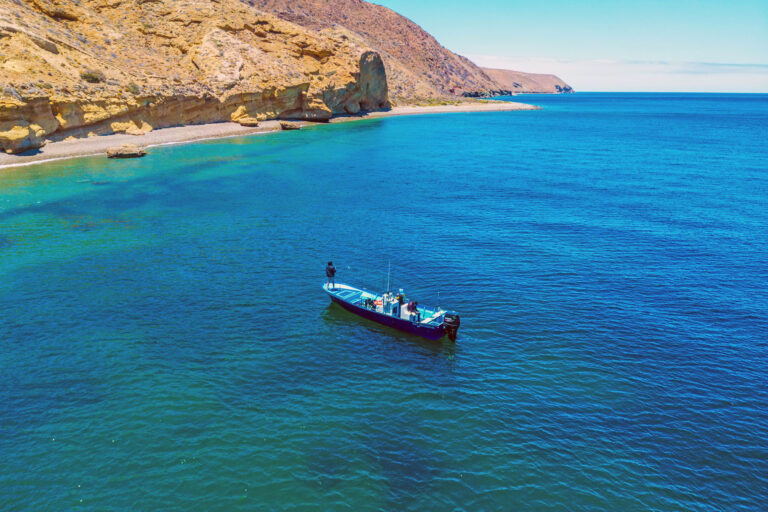Standing in a wind-blown lake full of large rainbow trout, I braced myself as another set of chest-high swells rolled in, tops foaming and spray flying. The wind had revved up again, gusting conservatively into the 50s, possibly more than 60 mph. The half-dozen anglers fishing the lake that afternoon stood with their backs to the blasts as spray and coarse sand from shore pelted hooded jackets and waders. The sound came as a whooshing staccato — rat a tat tat … rat a tat tat.
We were fishing in the sparse, dry rangelands of southern Argentine Patagonia, about 400 miles north of Tierra del Fuego, the ultimate end of the road. Our group of 12 had traveled well south to tussle with the largest rainbows on Earth in Lago Strobel, better known to anglers as Jurassic Lake.
How was the fishing? Choose any effusive superlative you like. They’re all accurate. The group took about a dozen trout over 20 pounds, maybe more. And at least two anglers caught more than 65 rainbows in a day — all more than 10 pounds.
 A spring day at Jurassic Lake in southern Argentina. It’s windy and cold and the fish are active close to the spawning river. One rainbow trout is in the net as an angler wades to shore to fight another.
A spring day at Jurassic Lake in southern Argentina. It’s windy and cold and the fish are active close to the spawning river. One rainbow trout is in the net as an angler wades to shore to fight another. Each of us hooked good numbers of trout in the 14- to 18-pound range — strong, beautiful fish with a penchant for acrobatics. This desert sink lake sits at 3,000 feet of elevation, and the fishing made for the trip of a lifetime, wind and all. Jurassic also offered that rare and valuable commodity of consistency.
On this gusty afternoon, the long processions of trout that headed toward the spawning river actually seemed energized by the blustery conditions. We quickly discovered that the wind and waves turned these fish on and caused them to feed more aggressively when the near-shore turbulence stirred up a rich brew of scuds and other aquatic insects.
To my left, a 15-pound trout as bright as a chrome hood ornament leapt from the choppy waters and cartwheeled repeatedly across the surface like a crazed gymnast. Tom Nygard’s 8-weight bowed, and he hollered as the trout jumped. “Look at this guy!” Nygard shouted. “Look at him. He’s ridiculous.”
Nygard and I later discussed his crazy dancer. “I had that one that came out of the water … what was it, 14 times?” asked Nygard, my roommate for the week and a retired Montana dealer of Western wildlife and sporting art who now lives in Florida. “It was amazing.”
 Jurassic rainbows grow fat on a rich diet of scuds and other insects.
Jurassic rainbows grow fat on a rich diet of scuds and other insects. Shortly after Nygard’s action, I hooked a rainbow of similar size that also streaked into the wind and waves, this one clearing the water a mere seven or eight times. Still spectacular. We both landed our fish. I stopped for a minute to soak it all in: the tireless wind, the green and white rollers, the obliging trout. Well out on the lake, the tempest roiled the surface waters, lifting the waves into clouds of spray.
It was as fine a day to be alive and fishing as I can recall. That morning, Nygard, trip organizer Pat Ford and I enjoyed a half-dozen triple headers as we fished the same beat to the left of the river mouth. “It’s a wonderfully magical place,” Ford said. “Every cast can be a 20-pounder. There’s no other place on Earth I’ve ever seen or heard of that’s like it. The place is not easy to get to. That’s why it’s so good.” It also comes at a cost. The rate per week is $7,500 per angler.
Spring
For the last week of September, the start of spring in the southern hemisphere, we were comfortably ensconced at Jurassic Lake Lodge. The lodge is but a five-minute walk from all four fishing spots, or beats, through which everyone rotates for half a day in groups of two or three.
As the lake’s only tributary, the Barrancoso River is the crucial spawning artery for the entire population of Jurassic rainbows. When we visited, the freestone river was low and chock-a-block full of fish waiting for their turn to push upstream. The fishing was excellent on both sides of the river mouth, with trout returning to their natal waters from all directions.
 Photographer Pat Ford with a rainbow trout that topped 20 pounds.
Photographer Pat Ford with a rainbow trout that topped 20 pounds. Even the peripatetic Ford, rarely at a loss for words, said it was difficult to capture the Jurassic experience in prose. “You really have to experience it,” says Ford, 78, a fishing and wildlife photographer and a retired Miami trial attorney who has fished around the world at dozens of lodges catering to fresh and salt. “There is no place in the world like this. And it’s just so visual. You have fish swimming at your feet, and they’re huge. Unbelievably huge. You have 15-pounders within reach of your rod tip.” All true. Every fish was released, and none of the hooks was barbed.
Use your imagination and picture a lightly blushed rainbow weighing 20 pounds sailing off into the wind-whipped waters of Lago Strobel while you watch your backing disappear. Or the sight of four or five freakishly large trout silhouetted like submarines in the green swells. Or imagine what it’s like to wade the shallow, thigh-deep mouth of the Barrancoso, brushing past dozens of behemoths as they fin and scatter, bumping into your legs while awaiting their chance to move upstream. That experience of extreme abundance we felt was a glimpse of the world before the fall, before humankind with its many hungers ran roughshod over it. Ford was correct: You really do have to experience it.
 Not only is Jurassic Lake Lodge comfortable and accommodating, but it is only a five-minute walk to all four ‘beats’ which guests rotated through.
Not only is Jurassic Lake Lodge comfortable and accommodating, but it is only a five-minute walk to all four ‘beats’ which guests rotated through. First Surprise
It took about an hour for the chartered twin-engine plane to ferry us north from El Calafate, where we’d spent the night, to the dirt airstrip that services the lodge. On the 15-minute drive to our home for the week, our guide stopped the SUV and beckoned us to peer over the steep canyon wall. My eyes adjusted to the shadowed perspective. Below, the Barrancoso pulsated with life. Hundreds of trout lined up flank to flank, nestled into the river as tightly as sardines in a can.
The sight seemed aptly fitting of the Jurassic moniker. “It’s almost like a prehistoric experience,” said Rodger Glaspey, a diehard rainbow warrior and a co-owner of the Rainbow King Lodge on Lake Iliamna in Alaska. “The land that’s been forgotten.”
To further the sense of antiquity, several ancient petroglyphs and rock engravings have been found around the lake, some reportedly dating back as far as 9,000 years. This is old, wild country, where beauty hides in the wind-scoured sparseness of the rugged land and time unfolds differently. “The nice thing about this place,” noted Glaspey, “is the world stops.” For a short time, there is opportunity to catch your breath and leave behind the life you live elsewhere.
 The river was low and full of spawning rainbow trout headed upstream.
The river was low and full of spawning rainbow trout headed upstream. Wind
You can’t talk about Jurassic without mentioning the wind. It is as much a part of the scene as the rugged, Mars-like topography, the cold, turquoise-colored lake waters, and the super-sized trout. A sign on a whiteboard at Jurassic Lake Lodge reads: Make friends with the wind.
That phrase was repeated with a touch of snark when gusts climbed into 50-mph territory. The wind blew a steady 30 to 35 mph most days and gusted between 45 to more than 50 mph for periods. Sometimes it laid down completely for maybe 30 to 45 minutes. On the windiest day, it blew about 50 mph and gusted above 60 mph. On the rare occasions when the wind paused, the lake grew slick calm, and the fishing slowed.
By the end of the first full day, each of us had made our own peace with the Patagonian wind gods. As a right-hander, I was thankful the prevailing northwest winds were mostly on my left arm. “If you can’t cast into the wind, boy you’re in trouble,” said Glaspey, a left-hander who was forced to use a backhand cast when it was really blowing, at which he is adept.
Even with the wind at its fiercest, a determined angler who can double-haul can get a fly into water that holds fish. Anyone considering a trip to Jurassic would do well to practice casting in a stiff breeze. I grew frustrated one afternoon trying to cast directly into a strong headwind at a rugged headland of volcanic rock jutting into the lake, a beat called The Bay of Pigs.
The windward side of the Pigs drops off sharply, and the guide said trout like to hug the edge, which was getting tattooed by waves. To my eye, it looked fishy. By casting 45 degrees to the wind, rather than directly into it, I could work my indicator and fly along the rock wall. I caught three trout between about 14 and 17 pounds before we retreated to the lee on the other side.
 The routine was eat, fish, sleep — repeat. The fishing was as fine as many of us had experienced.
The routine was eat, fish, sleep — repeat. The fishing was as fine as many of us had experienced. The trout were often closer to shore than we realized along the most productive beats, on both sides of the river mouth. Fish hit 20 to 30 feet from where I was standing. The water closest to shore could be discolored from blowing sand and waves, which made it difficult to spot trout moving through. To wit, I stopped once to dig my phone out of my wading jacket to check the time. My fly was trailing maybe 12 feet downwind from where I was wading, just over my knees, when a trout grabbed it.
I set the hook and turned at the sound of the guide on shore laughing. He’d seen the take. When I’d worked the fish close to shore, the hook pulled just as the guide was about to net an average-size trout of 10 to 12 pounds. We both laughed. “Easy come, easy go,” he said.
In addition to the beats on both sides of the river mouth and the Bay of Pigs, the fourth beat is a large pool up the Barrancoso behind the lodge named The Aquarium. The upper Barrancoso, which is smaller and flows into the Aquarium, is a prime spot for fishing dries. I caught a 10-pounder on a dry using a 5-weight. Later, I hooked a hefty, energetic male that went 14 to 15 pounds on a streamer using the same rod; that was a memorable back and forth.
 The rainbows in Lago Strobel were loud, aggressive and beautiful.
The rainbows in Lago Strobel were loud, aggressive and beautiful. The Fish
The rainbows of Lago Strobel are big and strong. There’s nothing dainty about them, and their striking colorations range from chrome to the rich, spotted spawning robes of reds, pinks and yellows. They leap with ease — think figure skater Kristi Yamaguchi in her prime — rip off line, thrash, flip, shake their heads, double back, and pull and pull some more. They break hooks, leaders and a few hearts. “They’re serious fish,” Ford said. “I had fish jump maybe a dozen times. It’s as exciting as trout fishing can get.”
One sure sign of a trout’s size is the speed with which it can take you into your backing. Ford estimates he took six fish over 20 pounds, including a chromed beauty that might have gone 23. “It dumped me into my backing instantly,” Ford recalled.
“You just hold on and pray,” said Ari Rosenberg, after landing one fish that weighed 21.6 pounds. The fight saw him reeling frantically from his backside when he slipped in the water and fell. Later, when the knot connecting his fly line to the backing jammed in the tip, Rosenberg sprinted away from the water to maintain tension while the guide improvised with some hand-lining until the hang-up was freed.
An avid Florida snook angler, Rosenberg estimated that he, his father and his brother Noah collectively lost five others in that range that they’d hooked on large dry flies. “These fish should almost be categorized as a new species,” said Rosenberg, who at 25 has fished more than a dozen lodges with his brother and his father, an avid travel angler. “They’re like iron. They were aggressive and loud and in your face. Every single trout seemed to be on steroids. It was like opening a portal to a new world in regard to rainbows. My view is forever skewed.”
 Most of the fly-fishing was done with 8-weight rods and floating lines. Jurassic rainbows eat a variety of dries, streamers and nymphs.
Most of the fly-fishing was done with 8-weight rods and floating lines. Jurassic rainbows eat a variety of dries, streamers and nymphs.This 12-person crew that Ford assembled was a fishy, well-traveled, experienced and comradely bunch. There were no raging egos. The second lodge owner in the group, Steve Selway, runs the Puma Lodge in Chiliean Patagonia. Selway was nursing a repaired shoulder, but he gamely caught fish. Marty and Roberta Arostegui, both renowned anglers, also were part of our cohort. Marty has set more than 400 International Game Fish Association world records, and his wife has more than 100. On this trip, Roberta potentially set a dozen new IGFA line class and fly records.
The lodge manager is a South African named Llewellyn “Lou” Claven, who cut his teeth in the Seychelles and elsewhere. Claven had two rules for the dining table protocol: no politics and no cellphones, unless they were for showing fish pictures. The dinner talk mainly covered fish, travel and the highlights of the day.
History
The origin of the Jurassic Lake fishery is improbable and serendipitous. It’s a fluke that there are any trout in the lake at all. Strobel had no trout until the early ’90s, when a landowner hatched a business plan to farm rainbows in the lake and nearby ponds. He successfully planted rainbow eggs, and the trout took, but he found no feasible way to get them to market, given the remoteness of the lake.
The fish-farming idea faded, but the trout thrived in the lake’s cool, oxygenated water that held an abundant scud population and lacked natural predators. The first fishing outpost was just a collection of tents with few amenities. It wasn’t until 2016 that the early encampment was upgraded into the current comfortable lodge, with it’s fine food and wine, 24-hour electricity, Wi-Fi and a staff that is eager to please. “The hospitality is off the charts,” Nygard said. “You can’t be anything but impressed when you think of where the lodge is. It’s that far out in the middle of nowhere.”
 Weather changed from chilly and windy to snow squalls to bright sunny days.
Weather changed from chilly and windy to snow squalls to bright sunny days. Tackle
Most of the lake fishing is done with 8-weight rods and floating lines. A 5- or 6-weight is perfect for the upper portions of the river and its small pools. I brought four rods — 5- to 8-weights — and used only the lightest and the heaviest.
It’s personal preference whether to fish with a strike indicator. I used one the first couple of days, then fished without it for the remainder of the trip. White indicators can be difficult to spot among foam and chop. I prefer pink or orange, in a couple of sizes.
Jurassic rainbows will eat a variety of dries, streamers and nymphs. A hot fly usually emerges over the course of the week and is likely to be sold at the lodge, which has a good selection. Many of the flies you can buy there are tied by Claven. I brought three sizes of 9-foot flourocarbon leaders (0X, 1X and 2X) and extra tippet. The lodge’s website (jurassiclake.com) has good information on travel, tackle and flies, rates, what to pack, contact information and more.
 World-record seekers Marty Arostegui (right) and his wife Roberta potentially set a dozen new records on this trip.
World-record seekers Marty Arostegui (right) and his wife Roberta potentially set a dozen new records on this trip.Numbers
When you’re dialed in at the right spot with the right fly, you can catch a remarkable number of fish. But in any group, some anglers stand apart. Ford and his friend Glaspey are two such hard-driving rainbow aficionados. Glaspey had a day when he caught between 60 and 70 fish, maybe more. “I had 10 fish on 11 casts at one point,” Glaspey recalls. “They were all 10 pounds and up.”
His guide called him a “fishing machine.” Glaspey and Ford intend to return in April, which is more conducive to dry fly-fishing. “My next challenge,” Glaspey says, “is I want a 40-fish day on dry flies.”
On our last full day, Nygard and I each caught more than 40 fish and were feeling pretty good. Ford came up to me around 5 p.m., with two hours of fishing left, and said: “It’s cold, I’m wet, and I just caught my 65th fish. I’m going back to the lodge to edit photos.”
Ford and Glaspey walk on water. “They’re fish gods,” Nygard concluded. “But it wasn’t a fishing contest. If you want to know who had the most fun, it might have been me.”
“Or me,” I added.

